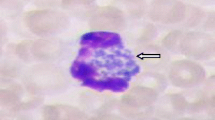Summary
Two experiments were carried out to determine ifBabesia major could be transmitted byBoophilus microplus. In experiment 1, aBabesia-free batch of laboratory rearedBo. microplus larvae were applied to an intact calf infected by inoculation with aB. major stabilate. The calf showed aB. major parasitaemia while the larvae, nymphs and adult ticks were engorging. The engorged females were cultured and batches were incubated at one of the three following temperatures: 24, 28 or 32°C. Approximately 10,000 larvae derived from each of the females were used to infest each of three splenectomized calves. In experiment 2,Babesia-freeBo. microplus larvae were applied to a splenectomized calf; the calf was injected withB. major stabilate and showed aB. major parasitaemia during the adult stage of tick development. The engorged females were incubated at room temperature and the resulting larvae (approximately 10,000) were used to infest a splenectomized calf. Examination of blood films for the presence ofB. major from the four calves infested by the second generation larvae in the two experiments were negative.
Similar content being viewed by others
References
Brocklesby, D. W. &Sellwood, S. A. (1973).Babesia major in Britain: tick transmitted infection in splenectomized calves.Research in Veterinary Science,14, 45–47.
Friedhoff, K. T. (1988). Transmission ofBabesia. In: Ristic, M., (Ed.),Babesiosis of domestic animals and man, CRC Press, Boca Raton, Florida, 23–52.
Lu, W. S., Yin, H., Lu, W. X., Yu, F., Zhang, O. C. &Dou, H. F. (1988). Discovery ofBabesia major from cattle and confirmation of its transmitting vector tick in China.Chinese Journal of Veterinary Science and Technology,12, 11–14.
Lu, W. S., Yin, H., Yu, F., Lu, W. X., Zhang, Q. C. &Dou, H. F. (1989). Studies on the transmission ability ofBabesia bovis andB. bigemina byBoophilus microplus.Chinese Journal of Veterinary Science and Technology,7, 10–11.
Lu, W. S., Yin, H., Lu, W. X., Zhang, O. C., Yu, F. &Dou, H. F. (1990). Experimental studies on the transovarial transmission ofBabesia major from bovine by tickHaemaphvsalis longicornis.Chinese Journal of Veterinary Science and Technology,6, 5–6.
Lu, W. S., Yin, H., Luo, J. X., Lu, W. X., Zhang, Q. C. & Dou, H. F. (1992). Discovery ofBabesia major in Xinjiang.Symposium of The Third Meeting of Chinese Society of Veterinary Parasitology, 220.
Mahoney, D. W. (1977). Babesia of Domestic Animals. In: Kreier J.P. (Ed)Parasitic Protozoa, vol.4, 1–52 and In: Kreier, J. P., (Eds),Babesiosis, Academic Press, New York, 1–24.
Purnell R. E. (1981) Tick-borne Diseases.British Veterinary Journal,137, 221–240.
Uilenberg, G., 1995, International collaborative research: significance of tick-borne hemoparasitic diseases to world animal health.Veterinary Parasitology,57, 11–19.
Author information
Authors and Affiliations
Rights and permissions
About this article
Cite this article
Yin, H., Lu, W., Zhang, Q. et al. Attempted transmission ofBabesia major byBoophilus microplus . Trop Anim Health Prod 29 (Suppl 4), 30S–32S (1997). https://doi.org/10.1007/BF02632913
Issue Date:
DOI: https://doi.org/10.1007/BF02632913




